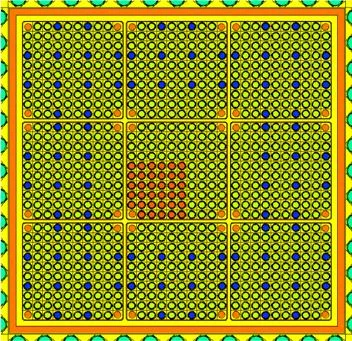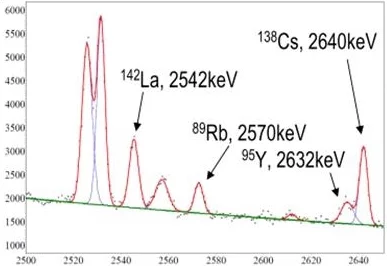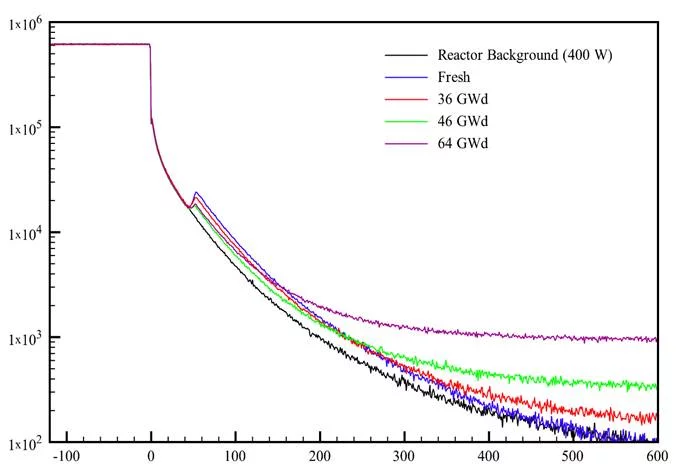The LIFE@PROTEUS experimental programme (Large-scale Irradiated Fuel
Experiments) has been the last programme carried out in the PROTEUS facility.
The programme started in 2006 and has been financially supported by the Swiss
utilities. The shutdown of the PROTEUS reactor in April 2011 prematurely ended
the programme. However, the first phases of the programme permitted, among
others, to develop novel measurement techniques that could be applied for spent
and fresh fuel characterisation.
Motivations
Fuel enrichments and discharge burn-ups have steadily increased to improve
the cycle lengths and thus reduce costs in an increasingly competitive
electricity market. In Japan, for example, the maximum fuel discharge burn-up
has been extended from 48 to 55 GWd/t and in Belgium to 50 and 55 GWd/t for MOX
and UO2 assemblies. In Eastern Europe the service life of assemblies
in WWERS is routinely extended to five cycles, i.e. 60 GWd/t, and in the US PWR
fuel discharge burn-ups has increased 35% during the 90s to about 50 GWd/t
batch average, and the present licensing limit is 62 GWd/t for the maximum rod
average burn-up. In Switzerland, maximum fuel discharge burn-ups are already
around 60 GWd/t, which allowed for example KKG to significantly reduced
front-end costs by reducing the number of fresh assemblies needed per loading
from 68 to 44.
Much has been gained already and before Fukushima, it was highly probable that the fuel burnup would continue to be increased in Swiss nuclear power plants. The reduction of fresh assemblies, as well as the corresponding burnt fuel assemblies also has ecologic advantages, on the one hand because the volume of waste and the long-term toxicity is reduced, and on the other hand because the proliferation risk is also diminished (lower amounts of plutonium and poorer plutonium quality).
The increase in discharge burnup, in conjunction with the increase of the initial U-235 enrichment and the special design developments associated with these cores such as part-length rods, new burnable poisons, etc., produces a more heterogeneous core configuration and consequently makes it more difficult to predict accurately the core behaviour. This makes the experimental validation of numerical methods particularly important. Those areas that could benefit from validation include the following:
Much has been gained already and before Fukushima, it was highly probable that the fuel burnup would continue to be increased in Swiss nuclear power plants. The reduction of fresh assemblies, as well as the corresponding burnt fuel assemblies also has ecologic advantages, on the one hand because the volume of waste and the long-term toxicity is reduced, and on the other hand because the proliferation risk is also diminished (lower amounts of plutonium and poorer plutonium quality).
The increase in discharge burnup, in conjunction with the increase of the initial U-235 enrichment and the special design developments associated with these cores such as part-length rods, new burnable poisons, etc., produces a more heterogeneous core configuration and consequently makes it more difficult to predict accurately the core behaviour. This makes the experimental validation of numerical methods particularly important. Those areas that could benefit from validation include the following:
- For nuclear fuel with very high burnups, it is important to guarantee an accurate predictability of characteristics such as decay heat, radioactive inventory, source term, toxicity, dose rates, and criticality safety.
- At beginning-of-cycle, for cores containing high-burnup fuel, the core power distribution becomes very heterogeneous due to strong neutron flux gradients between the fresh and highly burnt assemblies. This may be reflected in increased discrepancies of the in-core instrumentation, some times placed in between the assemblies or close to these interfaces. The validation of calculated pin power distributions in these core regions and the surrounding instrumentation is an important operational safety aspect.
- The increased core heterogeneity and changes in neutron spectrum due to high burnup has the potential for leading to larger uncertainties in safety parameters for example, in the case of the isothermal reactivity coefficient at beginning of cycle in PWRs, or in high-burnup, part-length-rod fuelled BWRs. The assessment of subcritical configurations e.g. during reloading, needs also to be validated for combinations of high-burnup and fresh, highly enriched fuel.
Research Activities
The programme of Large-Scale Irradiated Fuel Experiments at PROTEUS or
LIFE@PROTEUS, has been designed to provide scientific contributions to some of
the topics listed in the previous section. The following areas related to the
accuracy of code predictions were planned to be experimentally
investigated:
- Power distributions and power mismatch in fresh-burnt interfaces: Reaction rates in fresh and burnt fuel regions were to be measured and compared to calculational results, with particular emphasis on regions with strong neutron flux gradients that produce pronounced power distribution tilts. Following the (re-)irradiation of fuel rods in PROTEUS - with a maximum power of 1kW, both fresh and burnt rods were to be measured through gamma-scanning and neutron emission. The measured delayed gamma and neutron signals allow the determination of pin power distributions, as well as the effect on the instrumentation.
- Reactivity Effects: Nuclear assemblies and their surroundings were to be characterised via the determination of the reactivity worth of individual fresh and burnt fuel rods, contributing at the same time to the burn-up credit data. Safety-relevant parameters (e.g. reactivity coefficients) in different reactor-representative conditions were also to be given due consideration.
- Non-Invasive Characterisation of Burnt Fuel: Passive gamma- and neutron-emission measurements will allow the determination of axial and radial burnup distributions, gamma and neutron activity, and the concentration of fission products. These measurements would complement more precise destructive isotopic measurements performed on selected burnt rods at the Hot-Laboratory of PSI.
For the above experiments, PROTEUS, as compared to other facilities, offers
several advantages, such as the large experimental volume (~45*45 cm2 and 10m
high) to load either full-length or segments of fresh and spent fuel. Fresh fuel
pins with an U-235 enrichment of about 5 wt. % were to be used to be
representative of today’s enrichments, and two batches of burnt fuel pins were
to be studied in turn with initial enrichments of 3 to 5%, 10 years cooling
time and average burn-ups of about 40 and 60 GWd/t, respectively. This range is
characteristic of the latest average fuel assembly discharge burn-up in PWRs.
The programme was planned to be divided in three phases: one fresh’ phase with
only fresh fuel pins in PROTEUS test zone, and two spent’ phases with clusters
of ~40 and 60 GWd/t spent fuel surrounded by fresh fuel.
Core calculations has been performed to optimise the loading pattern guaranteeing a burnt-fresh interface representative of nuclear power plants conditions and also minimising the activity of spent fuel in the facility. An optimum bundle size of 6*6 spent fuel rods has been found.
Core calculations has been performed to optimise the loading pattern guaranteeing a burnt-fresh interface representative of nuclear power plants conditions and also minimising the activity of spent fuel in the facility. An optimum bundle size of 6*6 spent fuel rods has been found.
Achievements
Two unique measurement techniques to determine the fission rate induced by
the re-irradiation of spent fuel has been developed in the framework of
LIFE@PROTEUS. The techniques are based on measuring the delayed neutrons and
gamma-ray lines emitted after the re-irradiation at very low power of fresh or
spent fuel. Spent UO2 fuel samples fully characterised by
destructive analysis during the LWR-PROTEUS programme, with burn-up ranging
from 36 to 64 GWd/t, were measured and their fission rate compared to fresh
fuel samples. Experiments were further successfully compared to Monte Carlo
code predictions.
The delayed gamma measurement technique makes use of the high-energy gamma-rays (above 2200 keV) emitted by short-lived fission products freshly produced in the fuel, which have energies higher than the gamma-rays emitted by the intrinsic source of the spent fuel (Cs-137, etc.). The four gamma-ray lines La-142 (2542 keV), Rb-89 (2570 keV), Cs-138 (2640 keV) and Y-95 (3576 keV) have been identified as adequate for this measurement. Their contributions in the spectra measured with hyper pure germanium detectors are shown below (left) for a typical spent fuel. The spent fuel fission rate à relative to fresh fuel à determined by this technique has been shown to have a total uncertainty (1 sigma) of 2-4%. This technique, as well as the measurements performed in the context of LIFE@PROTEUS remains today unique.
The delayed neutron measurement technique makes use of the delayed neutrons emitted by the re-irradiated spent fuel to determine its fission rate during the re-irradiation. Delayed neutron signal measured with BF3 detectors are shown below (right) for different configurations (no sample, fresh sample, spent fuel samples). The useful signal is measured between one and two minutes after the reactor shutdown and is due to the three slowest groups of delayed neutrons. Fission rate predictions were obtained with larger total uncertainties, i.e. 3-6% at 1 sigma. This has been shown to be almost exclusively due to the uncertainties on nuclear data. This technique has also been applied for the first time to yield fission rate in spent fuel.
The delayed gamma measurement technique makes use of the high-energy gamma-rays (above 2200 keV) emitted by short-lived fission products freshly produced in the fuel, which have energies higher than the gamma-rays emitted by the intrinsic source of the spent fuel (Cs-137, etc.). The four gamma-ray lines La-142 (2542 keV), Rb-89 (2570 keV), Cs-138 (2640 keV) and Y-95 (3576 keV) have been identified as adequate for this measurement. Their contributions in the spectra measured with hyper pure germanium detectors are shown below (left) for a typical spent fuel. The spent fuel fission rate à relative to fresh fuel à determined by this technique has been shown to have a total uncertainty (1 sigma) of 2-4%. This technique, as well as the measurements performed in the context of LIFE@PROTEUS remains today unique.
The delayed neutron measurement technique makes use of the delayed neutrons emitted by the re-irradiated spent fuel to determine its fission rate during the re-irradiation. Delayed neutron signal measured with BF3 detectors are shown below (right) for different configurations (no sample, fresh sample, spent fuel samples). The useful signal is measured between one and two minutes after the reactor shutdown and is due to the three slowest groups of delayed neutrons. Fission rate predictions were obtained with larger total uncertainties, i.e. 3-6% at 1 sigma. This has been shown to be almost exclusively due to the uncertainties on nuclear data. This technique has also been applied for the first time to yield fission rate in spent fuel.



